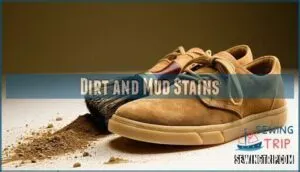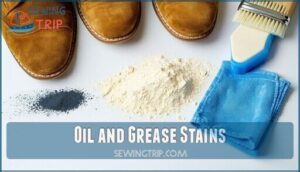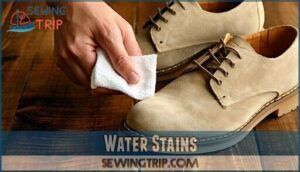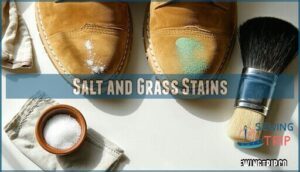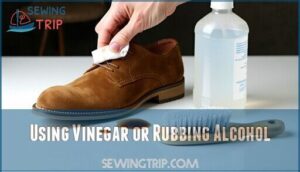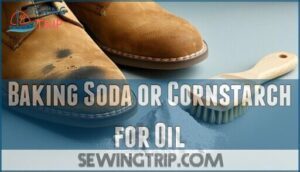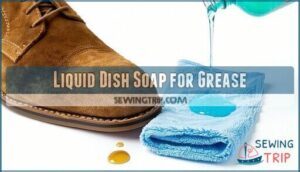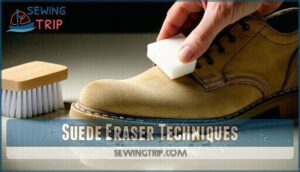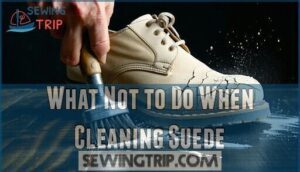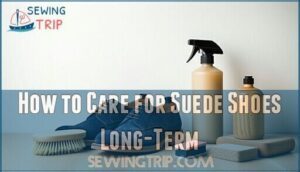This site is supported by our readers. We may earn a commission, at no cost to you, if you purchase through links.
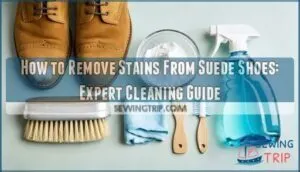 Removing stains from suede shoes requires patience and the right technique. Start by letting wet stains dry completely, then use a suede brush to restore the nap. For oil stains, sprinkle cornstarch on the spot and let it sit overnight to absorb grease. White vinegar works well for salt stains—dab gently with a cloth, then brush. Water stains often disappear once you brush the entire shoe uniformly.
Removing stains from suede shoes requires patience and the right technique. Start by letting wet stains dry completely, then use a suede brush to restore the nap. For oil stains, sprinkle cornstarch on the spot and let it sit overnight to absorb grease. White vinegar works well for salt stains—dab gently with a cloth, then brush. Water stains often disappear once you brush the entire shoe uniformly.
Always test cleaning methods on a hidden area first, and never soak suede with water. The key is working gently to avoid damaging the delicate surface. Different stain types require specific approaches that can save even heavily soiled shoes.
Table Of Contents
Key Takeaways
- Always let wet stains dry completely before cleaning – attempting to clean wet stains will spread them deeper into the suede fibers and cause permanent damage
- Use gentle household items like white vinegar, cornstarch, and suede brushes – you don’t need expensive cleaners when these common items effectively remove most stains without damaging the delicate material
- Test any cleaning method on a hidden area first – different suede types react differently, so you’ll avoid visible damage by testing your approach on an inconspicuous spot
- Never soak suede with water or use heat to dry it – excessive moisture ruins the texture permanently, and heat sources like hair dryers will crack and stiffen the material beyond repair
How to Remove Stains From Suede Shoes
Suede shoes can pick up stains from everyday wear, but you don’t need expensive cleaners to restore them. With the right household items and gentle techniques, you’ll remove most stains and keep your favorite suede shoes looking fresh.
Gather Necessary Cleaning Supplies
Before cleaning suede shoes, you’ll need specific supplies to tackle stains effectively. Start with a quality suede brush – its soft bristles lift dirt without damaging the delicate nap. Grab a suede eraser for stubborn marks, plus white vinegar and rubbing alcohol for liquid stains. Keep corn starch handy for oil absorption, and invest in quality cloth material for gentle application. Don’t forget protector sprays for future prevention. A specialized brush is essential for suede care.
Prepare Shoes for Cleaning
Preparing your suede shoes properly sets the stage for effective stain removal. Before tackling any marks, you’ll want to create the ideal cleaning environment.
- Let wet shoes air dry completely – never rush this step with direct heat
- Insert shoe trees or crumpled newspaper for shape retention during cleaning
- Use a suede brush to remove surface dirt and loose particles gently
- Test drying techniques in hidden areas before applying to visible spots
This foundation work prevents damage and makes subsequent stain removal more effective. Remember that you should never use water, as it can damage the suede’s delicate fibers.
Step-by-Step Stain Removal Process
Now that your shoes are prepped and ready, it’s time to tackle those stubborn marks. Start with Stain Identification to choose the right approach. Always do Product Testing on a hidden area first. Use Gentle Application techniques, working outward from stain edges. Follow proper Drying Techniques and finish with Residue Removal using your suede brush.
| Stain Type | Treatment Method | Drying Time |
|---|---|---|
| Oil/Grease | Cornstarch overnight | 8-12 hours |
| Water Marks | White vinegar dab | 2-4 hours |
| Dirt/Mud | Gentle brushing | Air dry first |
| Salt Stains | Rubbing alcohol | 3-6 hours |
| Grass Marks | Suede eraser rub | Immediate |
Removing Different Types of Stains
Different stains require specific approaches, and knowing which method works best can save your favorite suede shoes from permanent damage. Whether you’re dealing with everyday dirt or stubborn grease marks, the right technique makes all the difference in restoring your shoes to their original condition.
Dirt and Mud Stains
Dirt-and-mud stains don’t have to spell disaster for your suede shoes. Let wet mud dry completely before attempting removal—this prevents the stain from spreading deeper. **Once dry, use a gentle brushing technique with a suede brush to lift dirt particles.
**
For stubborn mud stains, vary your brushing pressure based on stain severity. The mud composition affects drying time, so patience pays off when cleaning suede shoes properly.
Oil and Grease Stains
Oil and grease stains require immediate action for effective removal from suede shoes. Absorbent powders like cornstarch or baking soda work as excellent pre-treatment options, absorbing up to 75% of fresh oil stains within two hours. Sprinkle powder generously over the stain and let it sit overnight.
For stubborn grease marks, try diluted dish soap applied sparingly with a soft cloth. Consider using a specialized grease remover for tougher stains.
Professional cleaning becomes necessary when stain age makes DIY oil stain removal ineffective.
Water Stains
Water stains on suede shoes create unsightly water rings and darkening effects that can ruin their appearance. Don’t panic – these marks are fixable with proper suede restoration techniques. The key lies in understanding how water affects suede fibers and using the right drying techniques.
- Brush gently while damp to prevent water rings from setting permanently
- Apply even moisture using a clean cloth to blend existing water stains
- Use prevention methods like waterproofing sprays to avoid future damage
Salt and Grass Stains
Winter’s harsh embrace leaves salt rings on your suede shoes, while summer adventures create stubborn grass residue. For salt stains, mix equal parts white vinegar and water, then gently blot the affected area. The solution dissolves salt crystals without damaging suede’s delicate texture.
For grass stains, use the same vinegar mixture but let it sit for thirty minutes before brushing. Regular cleaning with a suede brush can also help prevent dirt from setting in.
Prevention beats cure—apply waterproof spray monthly for seasonal care and effective suede stain removal.
Cleaning Suede With Household Items
You don’t need expensive specialized cleaners to tackle suede stains effectively. Common household items like white vinegar, baking soda, and dish soap can restore your suede shoes when used properly.
Using Vinegar or Rubbing Alcohol
For stubborn stains, white vinegar and rubbing alcohol work like magic on suede shoes. Dab a clean cloth with either solution and gently blot the stained area. Don’t soak the material—you’ll notice temporary suede darkening, but it’ll bounce back once dry.
To prevent future damage, consider using a suede protectant spray. Always brush afterward to restore that soft texture you love.
Baking Soda or Cornstarch for Oil
These powder alternatives work like tiny sponges, soaking up oil and grease stains effectively. Sprinkle baking soda or cornstarch generously over fresh or set-in stains, covering completely. Let sit several hours—stain age determines application duration. Brush away residue gently with a suede brush, restoring nap texture. Different suede types respond well to this gentle method.
For regular maintenance, consider using a specialized suede brush to prevent buildup.
Liquid Dish Soap for Grease
When grease strikes your suede shoes, liquid dish soap can be your secret weapon. Apply tiny drops of gentle soap directly to the stain, then dab with a microfiber cloth—never soak. The soap application breaks down stubborn grease through careful agitation techniques. Blot thoroughly for complete residue removal, respecting suede sensitivity. Air dry completely before brushing to restore texture.
Suede Eraser Techniques
With the right technique, a suede eraser becomes your go-to tool for stubborn stains and scuff marks. These specialized erasers work like magic on dry stains while restoring texture.
- Eraser types: Use specialized suede erasers or plain white pencil erasers for best results
- Pressure control: Rub gently in one direction to avoid flattening the nap
- Residue removal: Brush away eraser particles with a suede brush after treatment
- Texture restoration: Repeat erasing and brushing to revive matted areas and restore softness
What Not to Do When Cleaning Suede
When cleaning suede shoes, knowing what NOT to do is just as important as knowing the right techniques.
One wrong move can turn a simple stain into permanent damage that ruins your favorite pair.
Avoiding Water Damage
Water can wreck suede faster than you think. Never soak your suede shoes or use excessive moisture when cleaning. Instead, use damp cloths for spot treatment only.
Control humidity by storing shoes in dry areas. Apply suede protector spray before wear to prevent water stains. Proper drying techniques and suede waterproofing keep your investment safe.
Common Mistakes to Prevent
Beyond water damage, several cleaning blunders can ruin your suede shoes permanently. Many people make these costly errors without realizing the long-term consequences.
Here are the top mistakes that destroy suede:
- Over-wetting suede with excessive liquids or soaking methods
- Improper brushing against the grain or using stiff bristles
- Harsh chemicals like bleach, ammonia, or regular shoe polish
Ignoring stains until they set makes removal nearly impossible. Wrong storage in damp areas invites mold and warping. These missteps turn minor issues into major headaches for suede shoe care. Suede is especially delicate, so consider that bleach poses risks.
Safe Drying Methods
When drying wet suede shoes, patience pays off. Air drying in indirect sunlight prevents heat damage that can crack or stiffen the material. Never use direct heat sources like hair dryers or radiators.
Stuff shoes with newspaper or use shoe trees for shape retention during the extended drying time. Gently blot excess moisture with a dry cloth, avoiding rubbing motions that disturb the nap.
How to Care for Suede Shoes Long-Term
Once you’ve cleaned your suede shoes, proper long-term care keeps them looking sharp and extends their lifespan substantially. Regular maintenance prevents most stains and damage before they become serious problems.
Brushing and Maintaining The Nap
Regular brushing keeps your suede shoes looking fresh and extends their lifespan. Use a suede brush or soft bristle brush, working in the nap direction to lift fibers without damage.
Brush after each wear to remove dirt and restore the natural texture. For flattened areas, brush against the grain gently, then smooth back down for consistent nap longevity.
Applying Suede Protector Spray
Looking to shield your suede shoes from future stains? Apply suede protector spray every 3-6 weeks to maintain that invisible barrier against moisture and dirt. You can find a suitable suede spray product online.
- Product Selection: Choose fluoropolymer-based sprays over silicone alternatives for better stain prevention.
- Application Techniques: Spray evenly from 6-8 inches away in two thin coats rather than one heavy layer.
- Drying Time: Wait 30 minutes before handling; reapplication needs increase after wet conditions exposure.
Proper Storage and Moisture Prevention
Three simple storage rules protect your suede shoes from moisture damage. **First, choose cool storage areas with humidity control to prevent mold and cracking.
** Second, insert shoe trees to maintain shape while absorbing excess moisture. Third, use protective bags for long-term storage and conduct routine checks for early damage signs.
**Smart storage beats expensive repairs.
** To further protect your shoes, consider using waterproofing suede sprays.
Regular Maintenance Tips
Keep your suede shoes looking fresh by establishing a simple care routine. Brush regularly with a suede brush to remove surface dirt and restore the nap. Apply protector spray monthly to guard against stains. Use shoe trees for shape preservation during storage. Store in dry locations away from moisture. Perform routine checks for early stain detection, and brush away loose particles after each wear.
Frequently Asked Questions (FAQs)
Can I use soap and water to clean my suede shoes?
Skip soap and water—they’ll damage delicate suede fibers permanently. Instead, use specialized suede erasers, white vinegar, or rubbing alcohol on dampened cloths for stubborn stains while preserving texture.
Can suede shoes be machine-washed?
No, you shouldn’t machine-wash suede shoes. The water and agitation will damage the delicate material, causing shrinkage, stiffening, and loss of texture. Instead, use gentle hand-cleaning methods with suede brushes and specialized cleaners.
What should I do if my suede shoes get wet in the rain?
Ironically, just as you’re learning suede care, rain happens! Don’t panic—let them air dry naturally away from heat. Once dry, brush gently with grain direction to restore texture.
Can suede shoes be machine washed safely?
No, you shouldn’t machine wash suede shoes. The water and agitation will damage the delicate fibers, cause stiffening, and ruin the texture permanently. Stick to gentle hand-cleaning methods instead.
How long do suede shoes take to dry?
Suede shoes usually dry within 24-48 hours when air-dried naturally. Don’t rush the process with heat or sunlight, as this damages the material. Stuff them with newspaper to maintain shape while drying.
What temperature damages suede shoes permanently?
While suede loves gentle treatment, extreme heat above 140°F (60°C) will permanently damage the delicate fibers. You’ll want to avoid direct sunlight, radiators, and hair dryers—they’ll turn your soft suede stiff and brittle forever.
Are expensive suede cleaners worth the cost?
Expensive specialized cleaners aren’t necessary—common household items like white vinegar, rubbing alcohol, and baking soda work just as effectively for most stains while costing much less.
Can wet suede shoes be worn immediately?
Although you might think a quick rinse fixes everything, never wear wet suede shoes immediately. You’ll damage the material’s texture, cause permanent stains, and ruin the shoe’s shape. Always let them air dry completely first.
Conclusion
With practice, you’ll master how to remove stains from suede shoes using these proven techniques. Remember to always test methods on hidden areas first, work gently to preserve the nap, and let shoes dry completely between treatments.
Regular brushing and protective spraying prevent future stains. Don’t rush the process—patience yields the best results for keeping your suede footwear looking flawless for years.

